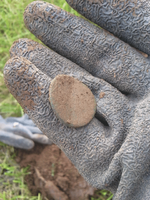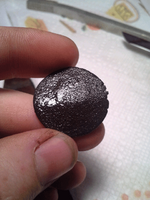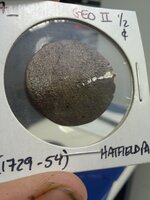cti4sw
Bronze Member
- Jul 2, 2012
- 1,555
- 919
- 🥇 Banner finds
- 1
- Detector(s) used
- Minelab Equinox 600, Garrett AT Pro, Pro Pointer
- Primary Interest:
- Relic Hunting
I didn't just break the century barriers, I decimated them with one swing
Found this today at the site of an early 19th century Mennonite meetinghouse. Not fully sure what it is, it's pretty toasted, but I'm reasonably sure it's older than a LC or HC (but I could be wrong).
First look, in situ

It's about 1.54" (27mm) in diameter. Before it went into the boiling peroxide I could barely make out a faint outline - unfamiliar to me, but enough to know it's not a LC or HC. Any ideas?
P.S. It's out of the peroxide and into some olive oil, where it will spend the night. I'm not too hopeful on detail from this thing, it's REALLY toasted, and looks like a plow hit it at one point. If I remember correctly it was between 10"-12" down.
Here's a quick look after a few minutes in the olive oil:

Here's the end result after 4 hours of electrolysis at 4.55Vdc/550 mA:

The electrolysis confirmed a suspicion that I've had since after the peroxide bath: that the lack of detail is due to corrosion rather than concretion, which no amount of cleaning can restore. So what bare, faintest detail exists is all I'm going to get. However, you can see more of the faint outlines in person than my cell phone camera will ever show, bc the phone wants to focus in on the corrosion itself rather than what the corrosion obscures. I'm 100% positive from what I can see that it's a George II.
Found this today at the site of an early 19th century Mennonite meetinghouse. Not fully sure what it is, it's pretty toasted, but I'm reasonably sure it's older than a LC or HC (but I could be wrong).
First look, in situ

It's about 1.54" (27mm) in diameter. Before it went into the boiling peroxide I could barely make out a faint outline - unfamiliar to me, but enough to know it's not a LC or HC. Any ideas?
P.S. It's out of the peroxide and into some olive oil, where it will spend the night. I'm not too hopeful on detail from this thing, it's REALLY toasted, and looks like a plow hit it at one point. If I remember correctly it was between 10"-12" down.
Here's a quick look after a few minutes in the olive oil:

Here's the end result after 4 hours of electrolysis at 4.55Vdc/550 mA:

The electrolysis confirmed a suspicion that I've had since after the peroxide bath: that the lack of detail is due to corrosion rather than concretion, which no amount of cleaning can restore. So what bare, faintest detail exists is all I'm going to get. However, you can see more of the faint outlines in person than my cell phone camera will ever show, bc the phone wants to focus in on the corrosion itself rather than what the corrosion obscures. I'm 100% positive from what I can see that it's a George II.
Last edited:
Upvote
1








 but, I think its better people know the truth. The pitting your getting is from the Electrolysis all those little dots that's from the Electrolysis. You over cooked it or used to many amps. Don't worry I've done it myself a dozen times and.... Sometimes the detail is just not there and with corrosion and pitting from baths and being in the elements for 200 years the detail has literally changed to corrosion and its not there anymore. I hope this helps,
but, I think its better people know the truth. The pitting your getting is from the Electrolysis all those little dots that's from the Electrolysis. You over cooked it or used to many amps. Don't worry I've done it myself a dozen times and.... Sometimes the detail is just not there and with corrosion and pitting from baths and being in the elements for 200 years the detail has literally changed to corrosion and its not there anymore. I hope this helps,


